Recently, I have been involved in surveys in the vicinity of the Eungella dam for an endangered native nightshade – Solanum graniticum.
Solanum graniticum is listed as endangered under both the Queensland Nature Conservation Act 1992 and the Commonwealth EPBC Act. This species is a ‘spindly, prostrate to sprawling, herbaceous…resprouting’ subshrub in the tomato family (Solanaceae), and was named by Queensland Herbarium taxonomist Tony Bean in 2004. It was recently elevated to endangered under the EPBC Act based on a nomination submitted by Jason Halford in 2019.

Solanum graniticum grows 20-30 cm tall, and may sprawl to a diameter of 1 m or so. It has spines to 9 mm long on the stems and the upper leaf surfaces (Bean, 2004) (and apparently on the lower leaf surface, although the specimens I examined closely did not). The leaves are shallowly to deeply lobed with 2-3 lobes per side, and are relatively small (to 2.6 x 1.3 cm). The lower leaf surface and the stems have a mid-dense to dense covering of stalked, stellate hairs. The upper surface has sparse-very sparse smaller stellate hairs (Simon Danielsen, pers obs).
This species is easily recognisable, and within its known range should not be confused with any other Solanum (Halford, 2019).
Solanum graniticum is endemic to north Queensland between Mackay and Townsville, where it is thought to be restricted to three disjunct populations (each are at least 100 km from the other). Each population is conservatively estimated to contain less than 250 individuals (i.e. the total species population is estimated at <1000 overall) (Halford, 2019):
- Cape Gloucester population: Cape Gloucester is the peninsula forming the south-eastern extent of Port Denison, 22 km directly south-east of Bowen. Until our surveys, this population was thought to be the largest of the three, although the species is described as rare (Halford, 2019).
- Mt Zero-Taravale population: a single collection was made in 2012 from the Mt Zero/Taravale wildlife sanctuary, 80 km west of Townsville in the Paluma hinterland (AVH, 2023). This population is 280 km from Cape Gloucester and 340 km from the Eungella dam. Population size here is unknown (estimated at less than 250 individuals at any one time – Halford, 2019).
- Eungella Dam population: a handful of plants were known from two adjacent collections on a hill-top directly overlooking the dam wall, in 2003 and 2011 (AVH, 2023). Halford (2019)

Solanum graniticum occurs in shallow soils derived from granite and granodiorite. It is most commonly associated with woodlands and open woodlands dominated by the ironbark Eucalyptus drepanophylla or E. crebra, with Corymbia erythrophloia, Lophostemon confertus, Allocasuarina littoralis and Corybia leichhardtii also noted as present in collection records (Halford, 2019; AVH, 2023).
Unfortunately for ecologists wishing to conduct targeted surveys for the species, E. drepanophylla/crebra woodland on granite soils are not in short supply in these areas, and this makes narrowing down a search area very difficult. This blog will attempt to assist this process by outlining where S. graniticum was found and my observations in relation to micro-habitat the species occupies in the vicinity of Eungella Dam (note – these observations may be of limited value to the other two populations, in particular the Mt Zero/Taravale population).

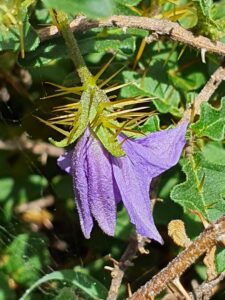
Survey findings
We found 101 individuals present in 10 sub-populations occupying approximately 88 ha, within an overall local extent of occurrence of 2360 ha (and I have reliable anecdotal evidence of another 14 plants in the vicinity). All potential habitat thought present has not been covered to date and it is highly likely the population within this extent of occurrence is considerably larger. The largest sub-population found was 5.2 ha in area and contained 41 plants. Another 35 plants were recorded within a 25 ha area nearby. One plant was found on the eastern side of the Broken River, less than 100 m from the high bank, on an apron slope.

Area of occurrence (AOO)
The spread of records from our surveys indicates an area of occurrence for the Eungella Dam population alone of 40 km2 (10 grid squares of 2×2 km as per the IUCN guidelines). However, using knowledge gained from these surveys in relation to habitat preference, and the distribution of that habitat type in the local landscape, I estimate that S. graniticum could have an AOO in the vicinity of the Eungella Dam of up to 80 km2.
The current documented AOO for the species is 28 km2 (Halford, 2019). Therefore, based on the findings of our surveys, total AOO for S. graniticum is now confirmed to be 68 km2, and could be as high as 108 km2 if our habitat projections are correct. This suggests that the Eungella Dam population is the prime population for the species, contributing more than 50% of the AOO.
Given these findings and their assumptions (ie that the vast majority of individuals present have been located), it is projected that the Eungella Dam population may contain 200-300 plants overall, which supports Jason Halford’s population estimate (Halford, 2019).
The extent of occurrence (EOO) for the species will not change as a result of these findings. In addition, the total estimated population size for S. graniticum of less than 1000 plants (Halford, 2019) appears to be supported.
Phenological observations
We observed S. graniticum flowering (profusely!) in November 2022. Previously, it has only been recorded flowering in March.
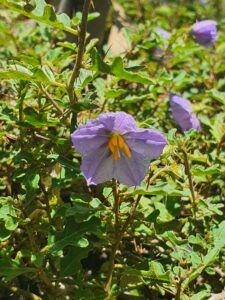

Microhabitat and survey observations
Solanum graniticum is a sprawling, low-growing (mostly less than 20 cm high) sub-shrub that, if not flowering, is easily overlooked. It is also genuinely absent from large areas of apparently suitable habitat – habitat that is common and well-represented in the Eungella Dam area. This makes it difficult to survey for. It is sometimes present as an isolated single plant with no other individual occurring within many hundreds of metres. The highest density recorded was nearly 8 plants per hectare, but this was unusual.
The plants we recorded were always growing in the RE 11.12.1 – woodland almost entirely dominated by E. drepanophylla. Corymbia erythrophloia and/or C. dallachiana were an occasional presence (i..e associated). In places, plants grew directly adjacent to the RE 11.12.16a (woodland dominated by Corymbia citriodora), but despite searches no individuals were located in that RE. It is also possible the species occurs in the RE 11.12.7, which is E. crebra woodland with vine thicket elements, although this RE tends to occupy steep slopes, and we did not find S. graniticum on steep slopes.

The woodlands in which it was found were grassy, with the predominant ground species being the exotic pasture grass Bothriochloa pertusa* (Indian bluegrass). We did not find S. graniticum where the ground layer had a dominant native species composition. This could be because such a ground layer (dominated by Heteropogon contortus, Themeda triandra, Cymbopogon refractus etc) is taller and more complex, and S. graniticum would be much harder to spot (as noted by Jason Halford).
Ground layer species associated with our records included Aristida gracilipes, Heteropogon contortus, Rhynchosia minima, Indigofera pratensis, Cyanthilium cinereum. Lantana camara* and Lophostemon confertus were present in places.
Solanum graniticum was occasionally found in open woodland mapped as non-remnant or regrowth, but despite numerous searches in adjacent cleared habitat, it was not located where there was no tree cover.
Individuals recorded during these surveys were also always associated with gently undulating slopes, usually on broad ridgelines but also on low rises and plains. We did not record it on hillsides or in gullies except very close to the ridgeline, although there was generally suitable habitat present on the hillsides. It was also only found where there was some soil development, and was not recorded where soils were skeletal with abundant surface cobble.
In addition, the plants we found were almost invariably situated adjacent to an object – usually a fallen log or the base of a tree, but occasionally among rocks. It could be that these structures provide protection from trampling, as all the areas we found S. graniticum individuals in were grazed.
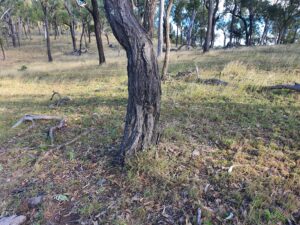
References
AVH, 2023, The Australasian Virtual Herbarium, Council of Heads of Australasian Herbaria, https://avh.ala.org.au/. Accessed 3/6/2023.
Bean, A.R., 2004, The taxonomy and ecology of Solanum subg. Leptospermum (Dunal) Bitter (Solanaceae) in Queensland and far north-eastern New South Wales, Australia. Austrobaileya 6 (4): 639-816.
Halford, J.J., 2019, Nomination form to change the conservation class of Solanum graniticum in Queensland. Dept. of Environment and Science, Brisbane.





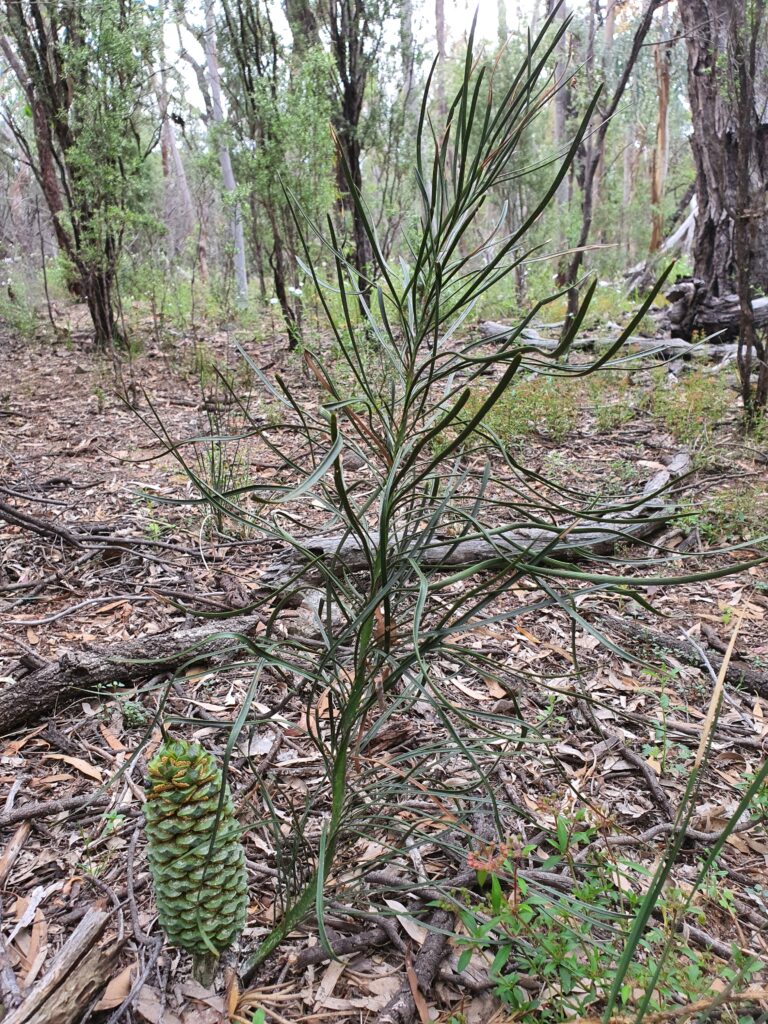

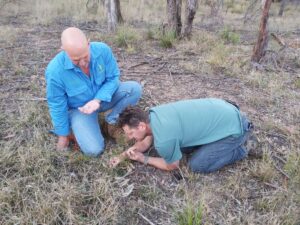
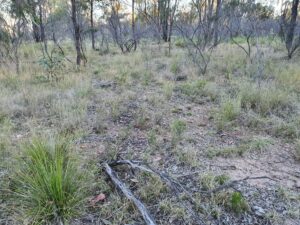

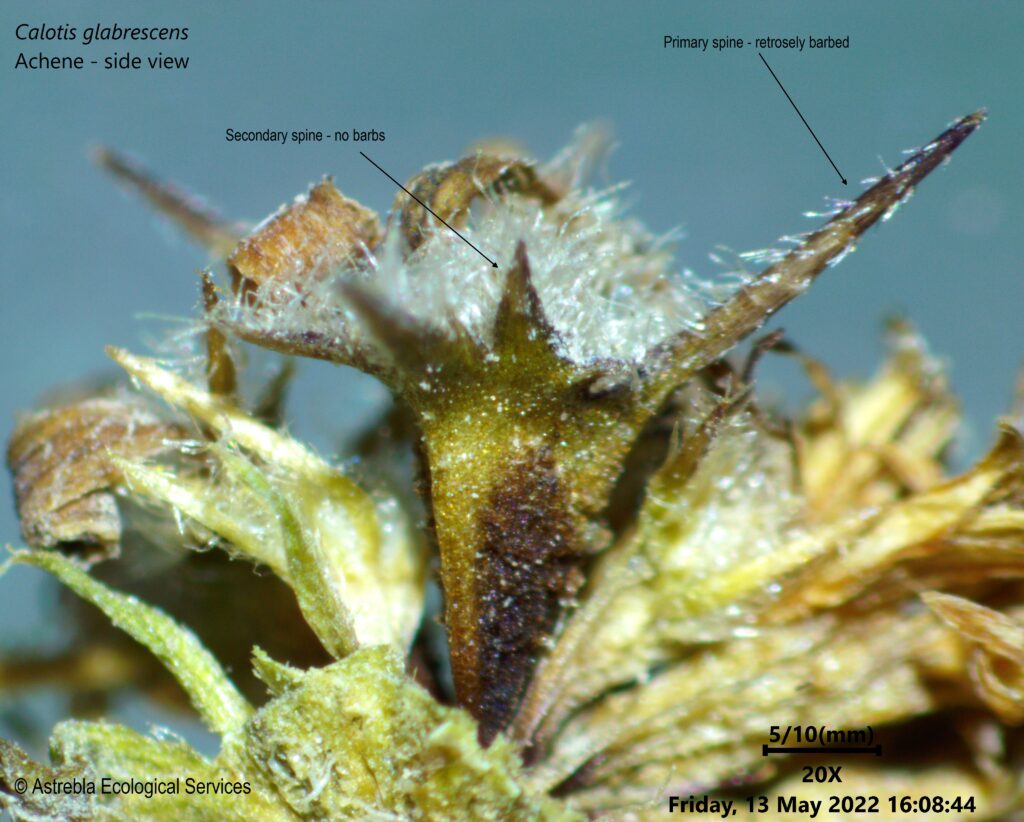
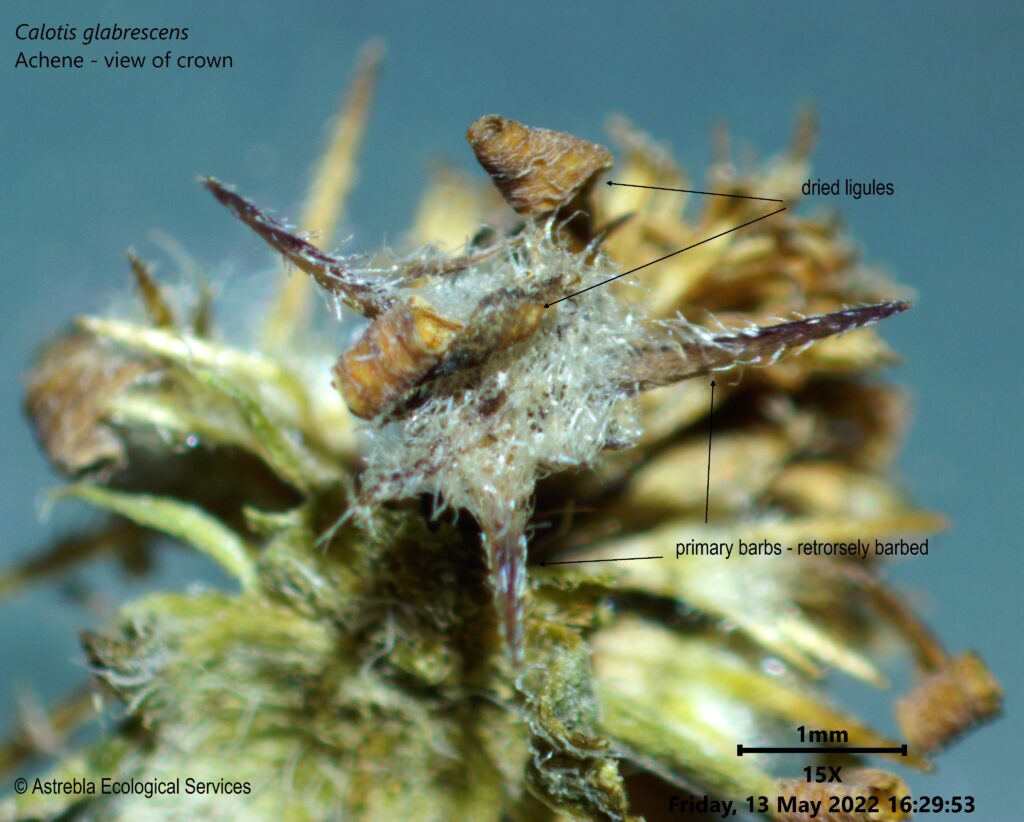

 We quickly located it, growing in the same grassland location as in 2000 (possibly from the same tuber). It was not flowering, however its presence in the same location as a previous confirmed record, and its conspicuously flanged/winged stems, suggested that is it highly likely to be O. turpethum.
We quickly located it, growing in the same grassland location as in 2000 (possibly from the same tuber). It was not flowering, however its presence in the same location as a previous confirmed record, and its conspicuously flanged/winged stems, suggested that is it highly likely to be O. turpethum. Typhonium praetermissum is a relatively cryptic perennial geophyte (i.e. a predominately subterranean herb) endemic to the Darwin/Litchfield area. It flowers and fruits in November and December, and appears to produce leaves only during the wet season, after which they quickly deteriorate and the plant disappears beneath the soil. The flowers are very delicate and exude an apparently unpleasant odour, but are quickly destroyed by ongoing wet season downpours, having a life of 1-3 days.
Typhonium praetermissum is a relatively cryptic perennial geophyte (i.e. a predominately subterranean herb) endemic to the Darwin/Litchfield area. It flowers and fruits in November and December, and appears to produce leaves only during the wet season, after which they quickly deteriorate and the plant disappears beneath the soil. The flowers are very delicate and exude an apparently unpleasant odour, but are quickly destroyed by ongoing wet season downpours, having a life of 1-3 days. There are some major difficulties in locating and accurately identifying Typhonium spp.. Flowers are generally required to key to species, however these are rarely encountered. In addition, most species have leaves that display extreme morphological variations (as can be seen in the accompanying photos), making even tentative ID difficult.
There are some major difficulties in locating and accurately identifying Typhonium spp.. Flowers are generally required to key to species, however these are rarely encountered. In addition, most species have leaves that display extreme morphological variations (as can be seen in the accompanying photos), making even tentative ID difficult.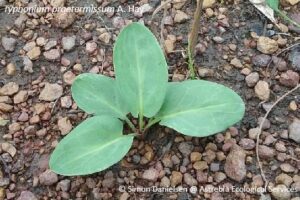 However, Dr Matthew Barrett of the WA Dept. of Biodiversity, Conservation and Attractions has developed a DNA barcoding technique that allows accurate and unambiguous identification to species of sterile material. Consequently, representative collections of leaf material were made from within the population of Typhonium individuals observed during our survey at Gunn Point and send to Dr Barrett for analysis and identification.
However, Dr Matthew Barrett of the WA Dept. of Biodiversity, Conservation and Attractions has developed a DNA barcoding technique that allows accurate and unambiguous identification to species of sterile material. Consequently, representative collections of leaf material were made from within the population of Typhonium individuals observed during our survey at Gunn Point and send to Dr Barrett for analysis and identification. As a result, the identification of the majority of the population observed to T. praetermissum was possible. In addition, a small number of T. johnsonianum were also confirmed present. Interestingly, of the many hundreds of individuals of both species observed during the surveys, only one individual had fruit – all of the remainder were sterile.
As a result, the identification of the majority of the population observed to T. praetermissum was possible. In addition, a small number of T. johnsonianum were also confirmed present. Interestingly, of the many hundreds of individuals of both species observed during the surveys, only one individual had fruit – all of the remainder were sterile. An interesting observation was that T. praetermissum was often present on disturbed surfaces, including spoon drains that are graded annually, and an old gravel pit.
An interesting observation was that T. praetermissum was often present on disturbed surfaces, including spoon drains that are graded annually, and an old gravel pit. In the photo to the left, Bob Harwood is pointing out a population of nearly 100 individuals we observed in a large gravel pit beside the main road.
In the photo to the left, Bob Harwood is pointing out a population of nearly 100 individuals we observed in a large gravel pit beside the main road.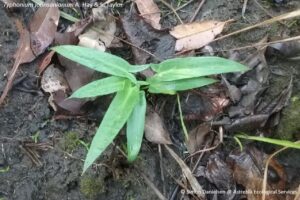 This species is very similar to T. praetermissum, but is less well known, being listed as data deficient in the NT. It has been recorded from the Alligator River floodplain, Kakadu National Park, and from the Humpty Doo and Noonamah areas. This survey represents the first collection from the Gunn Point area – as such, a range extension of approximately 30 km, which is relatively significant for a locally endemic plant with such a small range.
This species is very similar to T. praetermissum, but is less well known, being listed as data deficient in the NT. It has been recorded from the Alligator River floodplain, Kakadu National Park, and from the Humpty Doo and Noonamah areas. This survey represents the first collection from the Gunn Point area – as such, a range extension of approximately 30 km, which is relatively significant for a locally endemic plant with such a small range.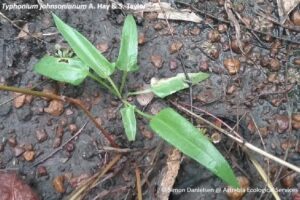 In general, T. johnsonianum displays less leaf-form variation than T. praetermissum – the leaves were invariably narrow triangular with a distinctive sagittate to hastate base, and a relatively short petiole. Some plants are more lanceolate, being cuneate to rounded at the base and lacking auricles.
In general, T. johnsonianum displays less leaf-form variation than T. praetermissum – the leaves were invariably narrow triangular with a distinctive sagittate to hastate base, and a relatively short petiole. Some plants are more lanceolate, being cuneate to rounded at the base and lacking auricles. I first became aware of these tiny ferns when they began popping up in my hanging plant pots! Soon I had a whole colony, and they transplanted well into tiny bonsai pots, although I had no idea what they were – there were only tiny, fairly non-descript leaves with blades about 10-15 mm long.
I first became aware of these tiny ferns when they began popping up in my hanging plant pots! Soon I had a whole colony, and they transplanted well into tiny bonsai pots, although I had no idea what they were – there were only tiny, fairly non-descript leaves with blades about 10-15 mm long.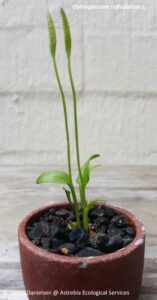 Those pictured here are Ophioglossum reticulatum L. (Ophioglossaceae), a tiny fern growing to 20 cm or so tall, and recorded from damp, shady situations among grass or on bare soil, often in eucalypt forest.
Those pictured here are Ophioglossum reticulatum L. (Ophioglossaceae), a tiny fern growing to 20 cm or so tall, and recorded from damp, shady situations among grass or on bare soil, often in eucalypt forest. The fruiting spikes (actually modified leaves) are shown in this image – they are approximately 5 cm tall, and their presence mark the members of Ophioglossaceae as quite different from other ferns – they are referred to by taxonomists as either fern allies or fern ‘oddities’.
The fruiting spikes (actually modified leaves) are shown in this image – they are approximately 5 cm tall, and their presence mark the members of Ophioglossaceae as quite different from other ferns – they are referred to by taxonomists as either fern allies or fern ‘oddities’.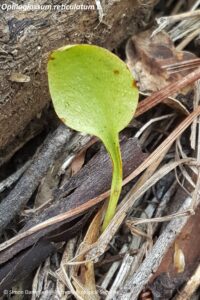 I also recorded this species on a survey I conducted in 2018 on the Evelyn Tablelands, growing on basaltic soil in Eucalyptus tereticornis open forest.
I also recorded this species on a survey I conducted in 2018 on the Evelyn Tablelands, growing on basaltic soil in Eucalyptus tereticornis open forest. These tiny leaves were barely noticeable among the leaf litter, but were spotted by my eagle-eyed mate Dave Hunter, whose curiosity and ability to pick out tiny orchids and other cyrptophytes is fast becoming legendary!
These tiny leaves were barely noticeable among the leaf litter, but were spotted by my eagle-eyed mate Dave Hunter, whose curiosity and ability to pick out tiny orchids and other cyrptophytes is fast becoming legendary!
 Listed as endangered in Queensland and under the EPBC Act, this species is a rare slender twining vine distinguished by its small lanceolate, herbaceous, opposite leaves with purplish-red petioles and clear sap
Listed as endangered in Queensland and under the EPBC Act, this species is a rare slender twining vine distinguished by its small lanceolate, herbaceous, opposite leaves with purplish-red petioles and clear sap Tylophora rupicola was recorded from low closed and open forests, mostly grassy, on rhyolite slopes in association with Lophostemon confertus, Acacia aulococarpa, Eucalyptus granitica, Corymbia abergiana, E. reducta, Allocasuarina littorlis, Syncarpia glomulifera and C. citriodora, always slightly upslope of rocky minor watercourses (regional ecosystems 7.12.30d and 7.12.66c).
Tylophora rupicola was recorded from low closed and open forests, mostly grassy, on rhyolite slopes in association with Lophostemon confertus, Acacia aulococarpa, Eucalyptus granitica, Corymbia abergiana, E. reducta, Allocasuarina littorlis, Syncarpia glomulifera and C. citriodora, always slightly upslope of rocky minor watercourses (regional ecosystems 7.12.30d and 7.12.66c). Dendrobium fellowsii F. Muell. (Orchidaceae) (native damsel orchid)
Dendrobium fellowsii F. Muell. (Orchidaceae) (native damsel orchid) Dallachy collected it in the 1860s from the Cardwell area, and it was described by Baron Ferdinand von Mueller in 1870. Mueller named it after Thomas Howard Fellows, a short-termed Attorney General of colonial Victoria and later a Supreme Court judge. Dendrobium fellowsii is also known as Eleutheroglossum fellowsii (F. Muell.) M.A. Clem. & D.L. Jones.
Dallachy collected it in the 1860s from the Cardwell area, and it was described by Baron Ferdinand von Mueller in 1870. Mueller named it after Thomas Howard Fellows, a short-termed Attorney General of colonial Victoria and later a Supreme Court judge. Dendrobium fellowsii is also known as Eleutheroglossum fellowsii (F. Muell.) M.A. Clem. & D.L. Jones.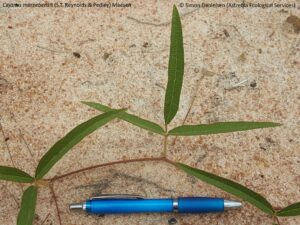 Cajanus mareebensis (S.T. Reynolds & Pedley) Maesen (Fabaceae)
Cajanus mareebensis (S.T. Reynolds & Pedley) Maesen (Fabaceae) Macrozamia conferta (D.L. Jones & P.I. Forster)
Macrozamia conferta (D.L. Jones & P.I. Forster)
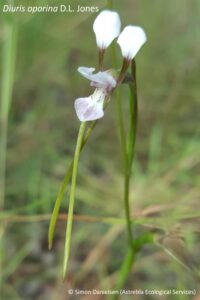 Diuris oporina D.L. Jones (Orchidaceae)
Diuris oporina D.L. Jones (Orchidaceae) Diuris oporina has until recently been thought to be restricted to the drier western ranges of the Atherton and Evelyn Tablelands in North Queensland. However, material collected as far back as 1953 (and apparently only identified recently) indicates this species has also been found in ranges in the vicinity of Airlie Beach and the Eungella Tableland, and from the Central Highlands in sandstone ranges of the Carnarvon Gorge and Palmgrove National Parks. These are significant range extensions, and indicate that much is yet to be learnt about this beautiful orchid.
Diuris oporina has until recently been thought to be restricted to the drier western ranges of the Atherton and Evelyn Tablelands in North Queensland. However, material collected as far back as 1953 (and apparently only identified recently) indicates this species has also been found in ranges in the vicinity of Airlie Beach and the Eungella Tableland, and from the Central Highlands in sandstone ranges of the Carnarvon Gorge and Palmgrove National Parks. These are significant range extensions, and indicate that much is yet to be learnt about this beautiful orchid.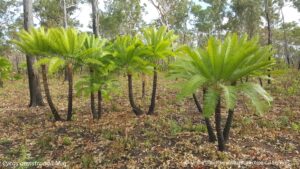 Cycas armstrongii Miq. (Cycadaceae)
Cycas armstrongii Miq. (Cycadaceae) This cycad is relatively easily identified as it has flat to recurved (not revolute) leaflet margins, ovoid-globose pollen (male) cones and densely orange tomentose, pungent cataphylls (illustrated in the lower image – cataphylls are the young leaves). The mature adult leaf blades are green and shiny.
This cycad is relatively easily identified as it has flat to recurved (not revolute) leaflet margins, ovoid-globose pollen (male) cones and densely orange tomentose, pungent cataphylls (illustrated in the lower image – cataphylls are the young leaves). The mature adult leaf blades are green and shiny. Aristida annua B.K. Simon (Poaceae)
Aristida annua B.K. Simon (Poaceae)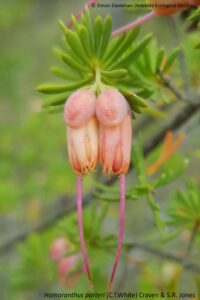 Homoranthus porteri (C.T. White) Craven & S.R. Jones (Myrtaceae)
Homoranthus porteri (C.T. White) Craven & S.R. Jones (Myrtaceae) Homoranthus porteri is restricted to upland areas of rock pavement in ranges along the western fringe of the Atherton Tableland, with outlying populations at Mt Windsor (inland from the Daintree River), Mt Mulligan and the Hann Tableland.
Homoranthus porteri is restricted to upland areas of rock pavement in ranges along the western fringe of the Atherton Tableland, with outlying populations at Mt Windsor (inland from the Daintree River), Mt Mulligan and the Hann Tableland.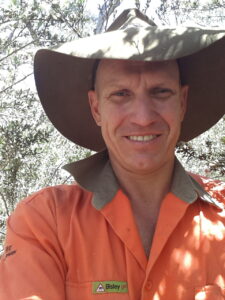 Simon Danielsen is a recognised ‘suitably qualified person’ under the Queensland Nature Conservation (Wildlife Management) Regulation 2006 to conduct protected plant surveys, and has conducted over 30 such surveys under the Protected Plant Survey Guidelines to date.
Simon Danielsen is a recognised ‘suitably qualified person’ under the Queensland Nature Conservation (Wildlife Management) Regulation 2006 to conduct protected plant surveys, and has conducted over 30 such surveys under the Protected Plant Survey Guidelines to date.